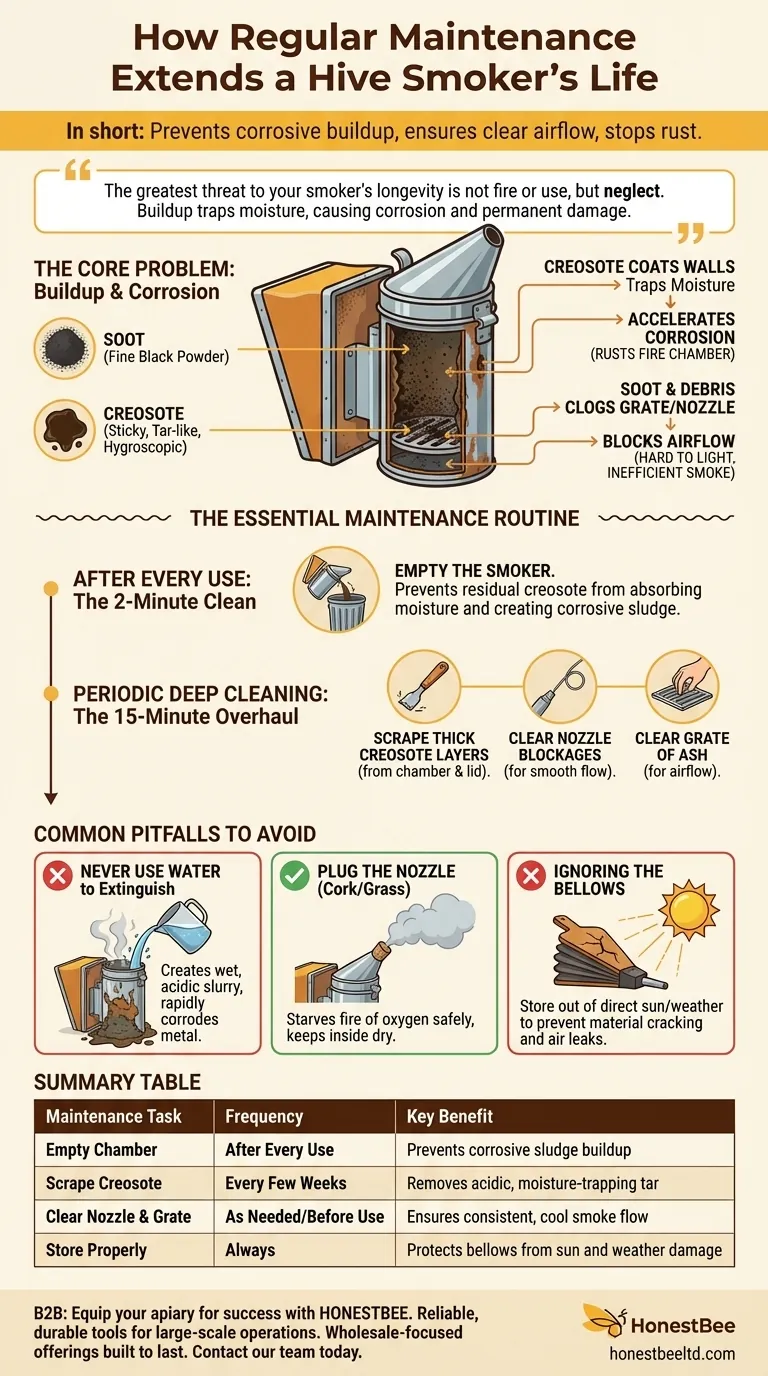In short, regular maintenance extends a hive smoker's life by preventing the buildup of corrosive materials and ensuring clear airflow. This simple process stops rust from eating through the metal components and keeps the smoker functioning efficiently, allowing it to provide calm, cool smoke for many years without needing replacement.
The greatest threat to your smoker's longevity is not fire or use, but neglect. The accumulation of soot and creosote traps moisture, causing blockages and corrosion that will permanently damage the tool far faster than normal operation.

The Core Problem: Buildup and Corrosion
A smoker is a simple tool, but the byproducts of combustion create a hostile environment for the metal it's made from. Understanding this is key to preserving it.
What is Creosote and Soot?
When you burn smoker fuel, the incomplete combustion creates two main byproducts: soot and creosote.
Soot is a fine black powder. Creosote is a tar-like, sticky substance that is both acidic and hygroscopic, meaning it actively attracts and holds moisture from the air.
How Buildup Damages Your Smoker
This combination of soot and creosote leads to the two most common points of failure for any hive smoker.
First, the sticky creosote coats the inner walls and traps moisture directly against the metal. This accelerates corrosion, or rust, which eats away at the fire chamber and can eventually cause the bottom to fall out.
Second, hardened soot and debris clog the grate at the bottom of the chamber and the nozzle at the top. This blocks airflow, making the smoker difficult to light, hard to keep lit, and inefficient at producing the cool, white smoke necessary for calming bees.
The Essential Maintenance Routine
A consistent cleaning schedule is simple and takes very little time, but it is the single most effective way to ensure your smoker's reliability and longevity.
After Every Use: The 2-Minute Clean
The most critical maintenance step is to empty the smoker after you are finished in the apiary.
Leaving unburnt fuel and ash in the chamber overnight allows the residual creosote to absorb ambient moisture, creating a corrosive sludge that sits against the metal. Simply dumping the contents and ensuring the chamber is empty prevents this.
Periodic Deep Cleaning: The 15-Minute Overhaul
Every few weeks, or whenever you notice performance declining, a deeper clean is necessary.
Use your hive tool to scrape the thick layers of creosote from the inside of the fire chamber and the underside of the lid. The goal is not to get to bare metal, but to remove the flaky, built-up layers.
Use a thin stick or wire to clear any blockages from the smoker's nozzle. This ensures a smooth, predictable flow of smoke. Finally, lift out the grate or spacer at the bottom of the chamber and clear it of ash and debris to maintain proper airflow.
Common Pitfalls to Avoid
Correct maintenance is as much about avoiding bad habits as it is about performing good ones.
Never Use Water to Extinguish Your Smoker
Dousing the fuel with water is the fastest way to destroy a smoker. This creates a wet, acidic slurry of ash and soot that will rapidly corrode the metal can.
The correct method is to plug the nozzle with a cork or a clump of green grass. This starves the fire of oxygen, extinguishing it safely while keeping the inside of the smoker dry.
Ignoring the Bellows
While the metal can is the focus of cleaning, the bellows are the smoker's engine. Store your smoker out of direct sunlight and extreme weather.
Prolonged sun exposure can dry out and crack the leather or vinyl material, causing air leaks that make the smoker useless.
Making the Right Choice for Your Goal
Your maintenance focus may shift slightly depending on your immediate priority.
- If your primary focus is reliability during inspections: Prioritize cleaning the nozzle and grate before each use to guarantee consistent airflow and smoke production when you need it most.
- If your primary focus is long-term durability: Focus on emptying the smoker after every use and performing periodic deep cleans to remove the corrosive creosote before it can cause irreversible rust damage.
A well-maintained smoker is not just a tool; it is a reliable and trustworthy partner in the apiary.
Summary Table:
| Maintenance Task | Frequency | Key Benefit |
|---|---|---|
| Empty Chamber | After Every Use | Prevents corrosive sludge buildup |
| Scrape Creosote | Every Few Weeks | Removes acidic, moisture-trapping tar |
| Clear Nozzle & Grate | As Needed/Before Use | Ensures consistent, cool smoke flow |
| Store Properly | Always | Protects bellows from sun and weather damage |
Equip your apiary for success with HONESTBEE. A reliable hive smoker is just the beginning. We supply commercial apiaries and beekeeping equipment distributors with the durable, high-performance tools needed for efficient, large-scale operations. From smokers to protective gear, our wholesale-focused offerings are built to last. Let's discuss your needs — contact our team today to explore our full catalog and wholesale pricing.
Visual Guide

Related Products
- Premium Traditional Copper Bee Smoker with Bellows
- Stainless Steel Honey Bee Smoker Hive and Honeycomb Smoker for Beekeeping
- European Stainless Steel Bee Smoker for Honey Bee Hive
- Economy Galvanized Beekeeping Honey Bee Smoker for Wholesale
- Stainless Steel Electric Beehive Smoker for Beekeeping and Bee Keeper Use
People Also Ask
- What are the main components of a bee smoker? A Guide to Safe and Effective Hive Management
- What is the primary purpose of using smoke in beekeeping? Calm Bees for Safer Hive Management
- How did early beekeepers use bee smokers? Master Ancient Bee Calming Techniques
- What is a Smoker and how is it used in beekeeping? The Essential Tool for Calm, Safe Hive Inspections
- How does water mist work as an alternative to smoke in beehives? A Guide to Safe & Effective Use



















